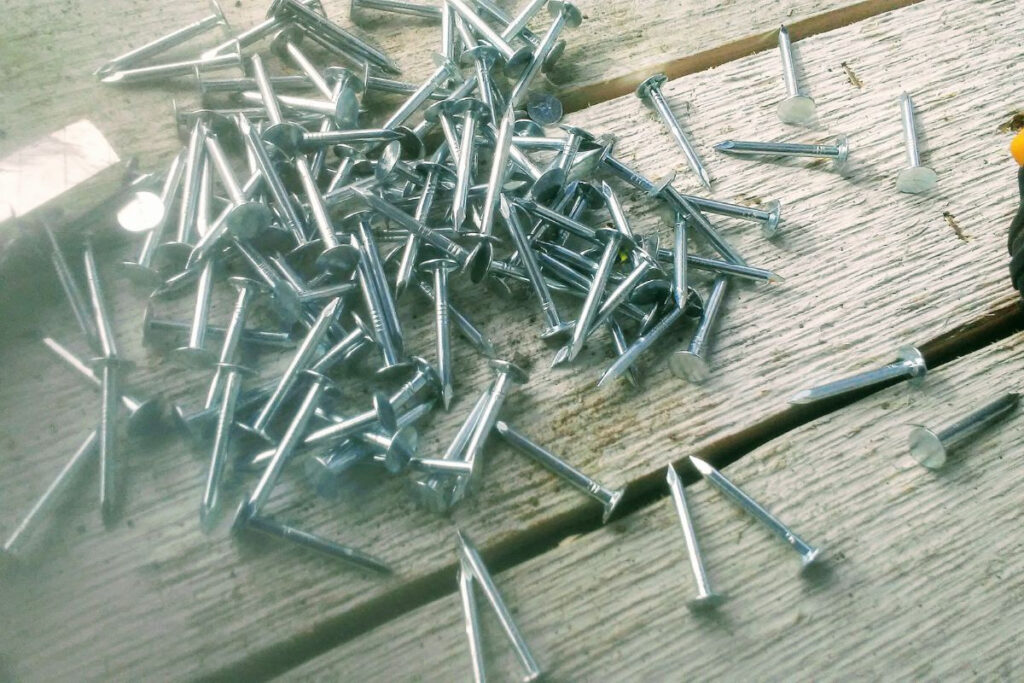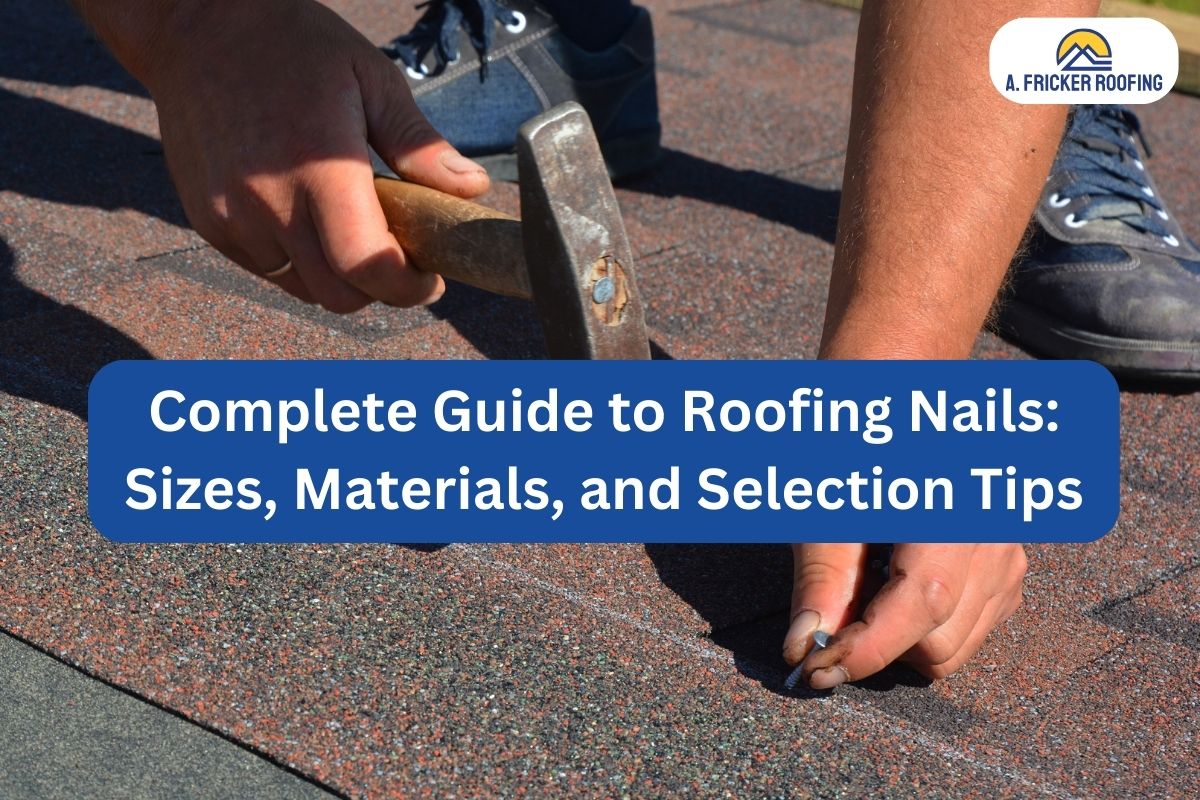Whether you’re a professional roofer, a seasoned DIY enthusiast, or merely someone trying to navigate through their first roofing project, understanding the intricacies of roofing nails is essential. With numerous sizes, materials, and styles available, it can be challenging to know where to begin when it comes to choosing the right nails for your project.
But don’t worry, this comprehensive guide explains everything about roofing nails. From size specifications and material differences to tips on selecting them based on specific project requirements – this blog post aims to provide you with everything you need to know.
Types of Roofing Nails
It’s important to note that not all roofing nails are created equal. Each type has its own unique purpose, depending on the roofing material used and local weather conditions.
1. Smooth Shank

Smooth shank nails are common in many residential projects due largely to their cost-effectiveness. As the name suggests, these nails have a smooth surface, which allows them to penetrate easily into most types of softwood roof decks or asphalt shingles.
2. Ring Shank

When extra holding power is needed, ring shank or ‘threaded’ nails are employed. The ringed pattern provides greater resistance against outside forces compared to their smooth shank counterparts.
3. Square Cap
Square cap nails have a flat head design that creates a larger surface area—this makes it more difficult for them to pierce through thin materials such as metal sheets or cedar shakes.
4. Non-Collated Roofing Nails

Non-collated roofing nails, meanwhile, are perfect when you need to apply a relatively small number of fasteners and don’t require the efficiency offered by coiled or strip nailers.
Each type is designed with specific advantages in mind, and understanding these distinctions will help guide you on what selection is best for your project’s needs.
Roofing Nail Materials
Nail materials are a crucial consideration in the selection of roofing nails. They determine longevity, grip strength, and are suitable for different climatic conditions. Here, I’ll walk you through some of the most common nail materials.
1. Stainless Steel Roofing Nails
Stainless steel is an excellent choice for roofing nails due to its superior corrosion resistance. These nails can weather various environments without compromising their integrity, making them a go-to choice in coastal areas.
Besides durability, stainless steel nails offer great strength. They rarely bend or deform under pressure; thus, they firmly hold the roofing materials in place.
However, it’s important to note that stainless steel tends to be more expensive compared to other roofing nail materials.
2. Electro-Galvanized Steel Roofing Nails
Electro-galvanized steel roofing nails, also known as galvanized roofing nails, are a popular and cost-effective alternative to stainless steel. The galvanization process involves applying a thin layer of zinc to protect the nail from rust and corrosion.
These nails may not last as long as stainless steel versions when exposed continuously to harsh weather elements, but perform exceptionally well under regular conditions.
3. Copper
Copper nails are robust and boast excellent durability similar to stainless steel. Notably advantageous is copper’s compatibility – these nails blend seamlessly with many roof materials like slate and clay tiles without causing any chemical reactions.
On the downside, the copper color turns green over time due to oxidation – this could detract from your roof’s aesthetics if not carefully planned for.
4. Aluminum
Aluminum nails are a popular choice due to their capacity to resist rust and fair performance in most weather conditions.
While they are versatile, aluminum nails should not be used in coastal areas as they may lead to corrosion. The relatively softer nature of this metal class often makes it vulnerable under high-stress situations. Therefore, hammering must be done with precision to avoid deforming the nail shape.
Features of Roofing Nails
Features of roofing nails significantly influence both the functionality and effectiveness of your roofing project.
1. Nail Length (in inches)
Choosing the right nail size is important to ensure it penetrates all the necessary layers without causing any damage to the underlying materials. This is crucial to maintain the quality of the material and avoid any unnecessary repairs.
Generally, professional roofers advise using 1-inch or no larger than 2-inch nails for asphalt shingles. However, these recommendations can depend on several factors, including local building codes and weather conditions.
2. Cap Type
Roofing nail cap types are often dictated by two forms: button caps or square caps. Button cap roofing nails feature a plastic or metal cap that’s roughly an inch in diameter. They’re mainly used to attach lightweight insulation boards before roofing application.
On the other hand, square cap nails come in handy when securing thicker materials as their large, flat surface provides a secure grip while preventing tearing.
3. Cap Shape
When it comes to cap shape, two common options are umbrella-shaped caps and flat heads. Umbrella caps are designed to offer more displacement on top, which helps them stay put even in harsh wind conditions. This feature makes them particularly useful in areas with stormy weather.
On the other hand, flat heads provide less displacement but offer higher resistance against pull-out forces. This makes them better suited to high load-bearing applications, such as installing heavy shingles.
4. Shank Type
Roofing nails come in four different shank types: smooth, ringed, screw, and spiral. Smooth shanks are easy to drive, but they offer less holding capacity than the other three types. Ringed shanks, on the other hand, reduce the possibility of withdrawal by increasing friction within the wood. For even greater holding power, you can find screw and spiral shanks, which are especially useful in environments with strong winds.
5. Nail Coating
Roofing nails are often polished with a coating to provide an extra layer of protection against corrosion. This is especially important for homes in coastal regions where saltwater can cause damage. There are several types of coating available, including electro-galvanized steel as mentioned above. Each type has its own strengths and is ideal for specific environmental conditions.
Factors to Consider When Choosing Roofing Nails
When selecting roofing nails, it’s critical to take into account a variety of factors. These include compatibility with the roofing materials on your building project, weather resistance, corrosion resistance to ensure long-lasting performance, and durability, which are essential features in robust construction.
- Compatibility with Roofing Materials
- Weather-Resistance Of The Nails
- Corrosion Resistance
- Durability and Strength
Conclusion
Choosing the correct roofing nail requires careful consideration of all these variables. Whether you’re a professional roofer or DIY enthusiast just starting your first project, remember that understanding your needs and requirements will help you make an informed decision. And of course, when in doubt, don’t hesitate to seek an expert opinion.
Contact A. Fricker Roofing and Waterproofing In Tulsa, OK, For Your Roof Installation
If you are starting up a roofing project in Tulsa, OK, consider hiring our team of roofing professionals, as they can guide you through the process. Contact our expert roofers at A. Fricker Roofing and Waterproofing in Tulsa, OK, for your roof replacement or a new roof installation. Call us today at (918) 402-7167 and consult with a roofing professional.

